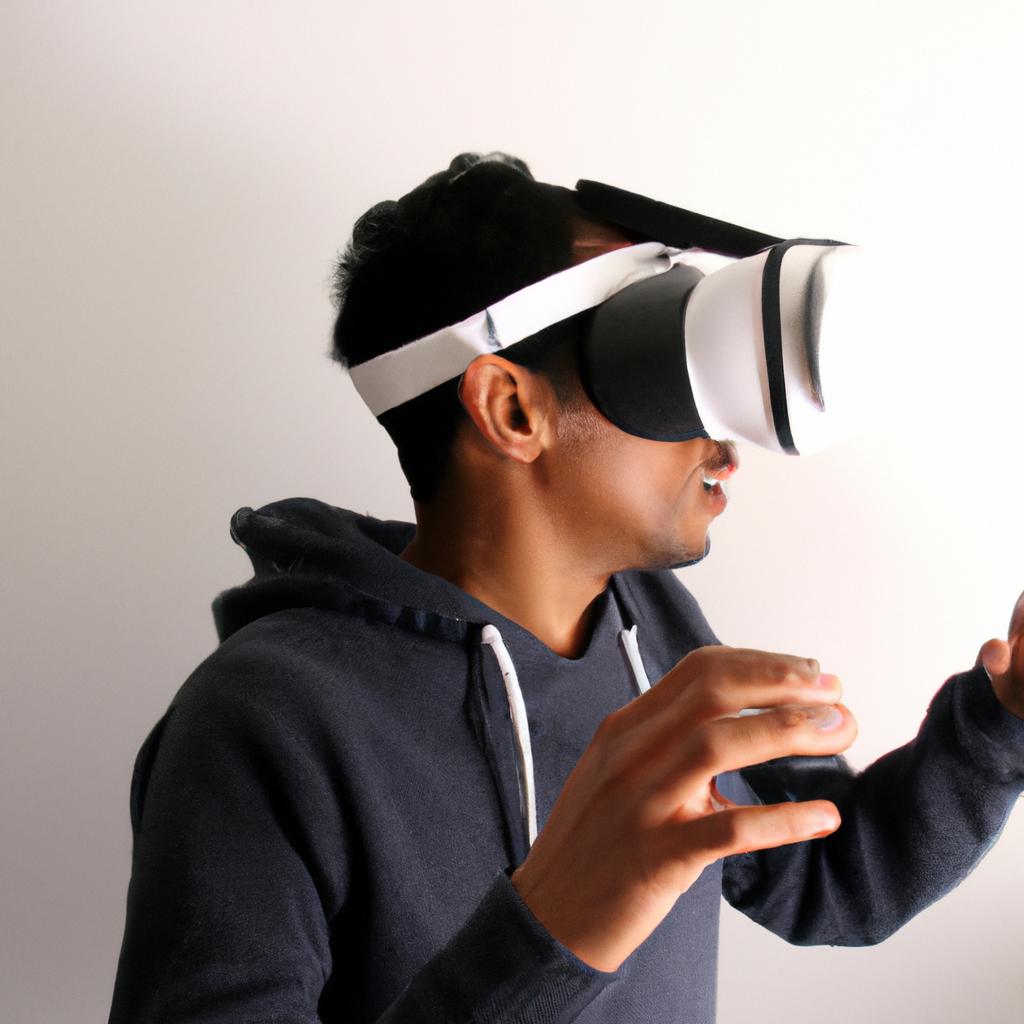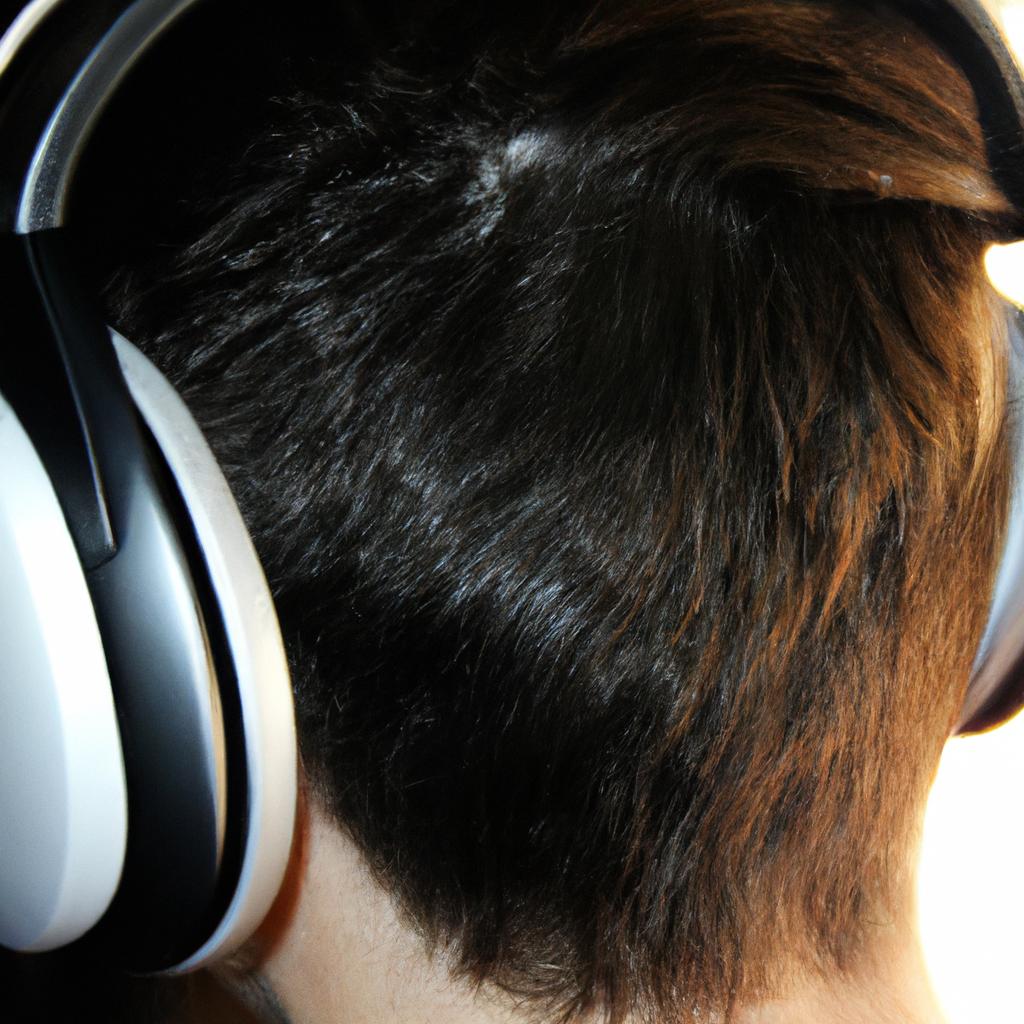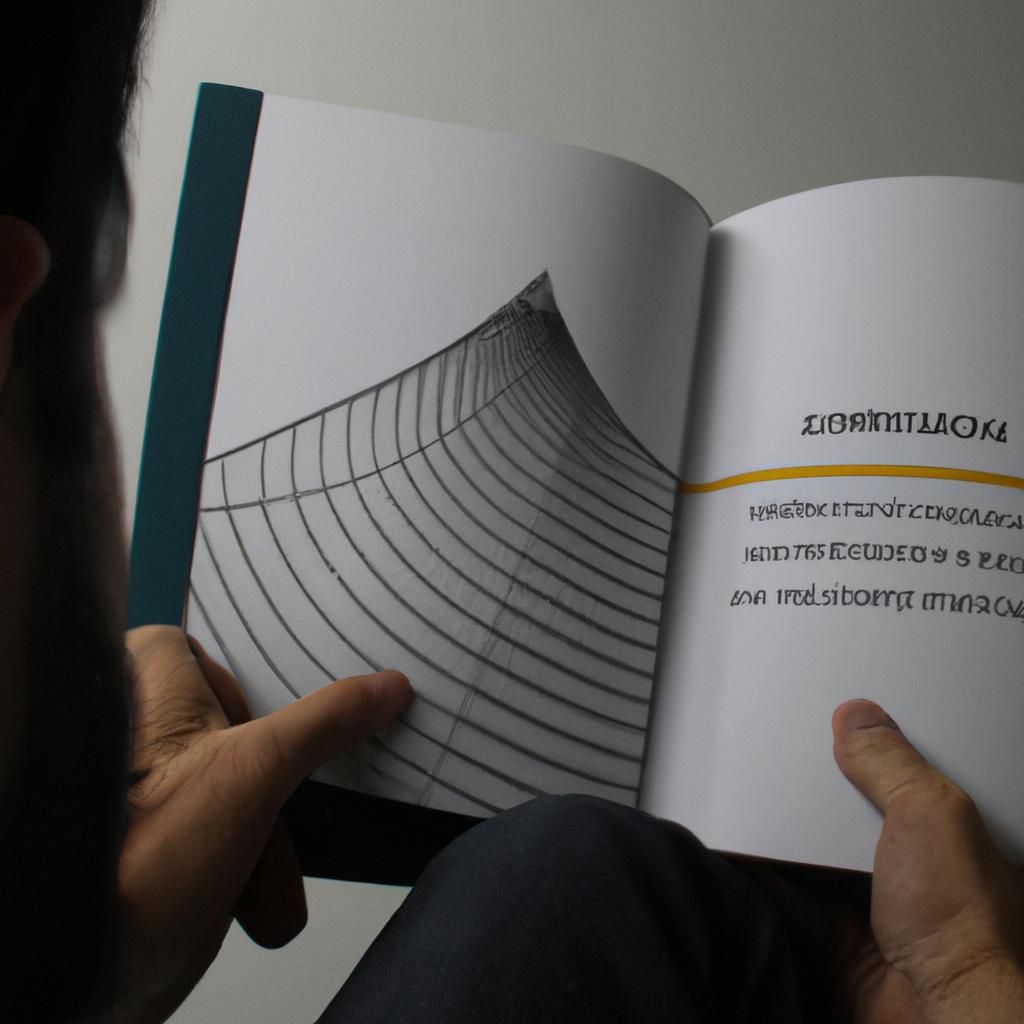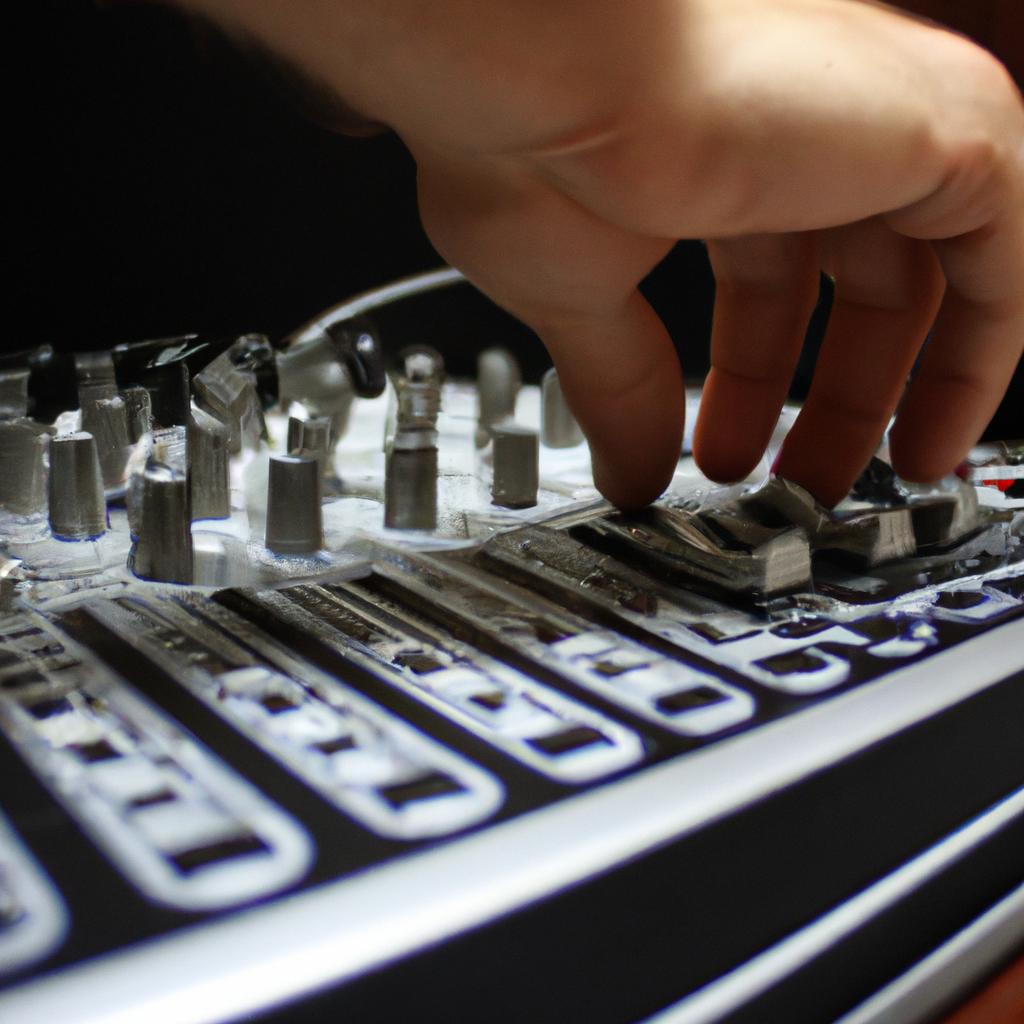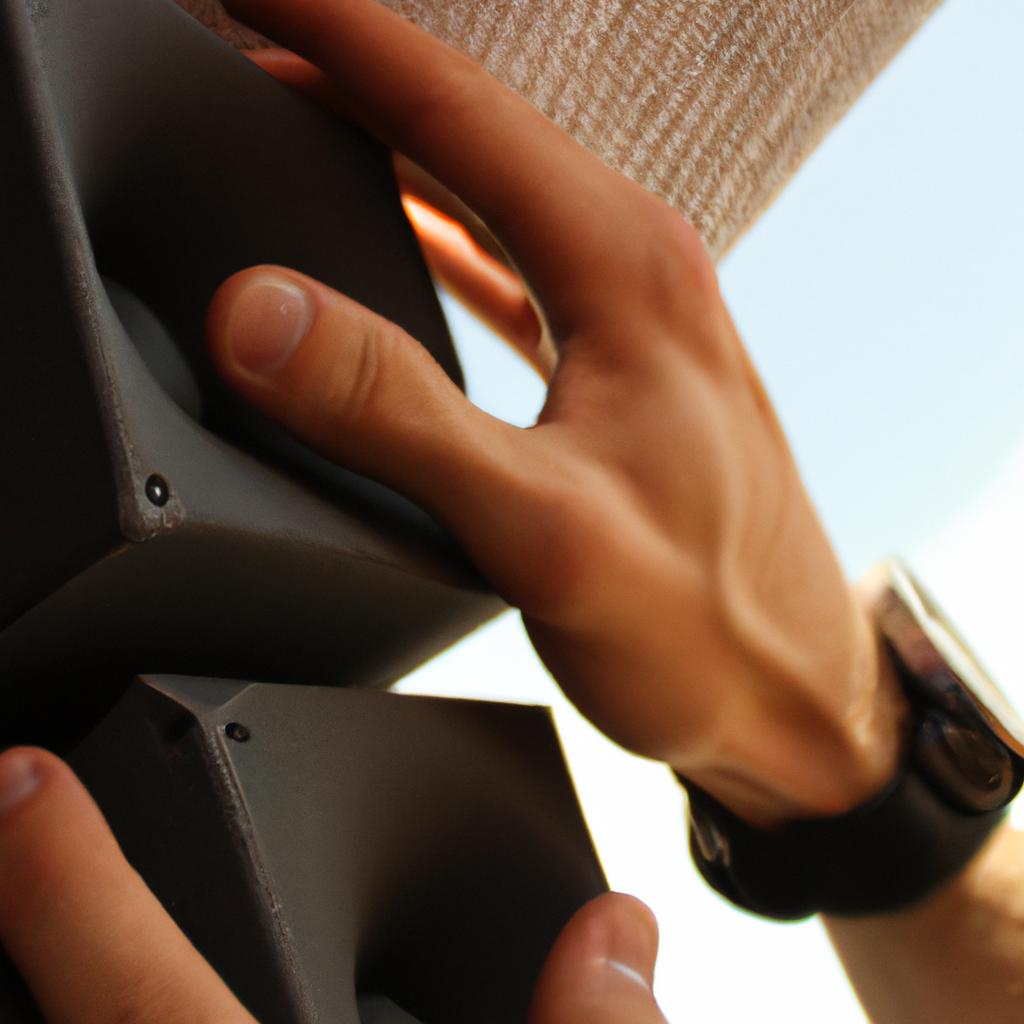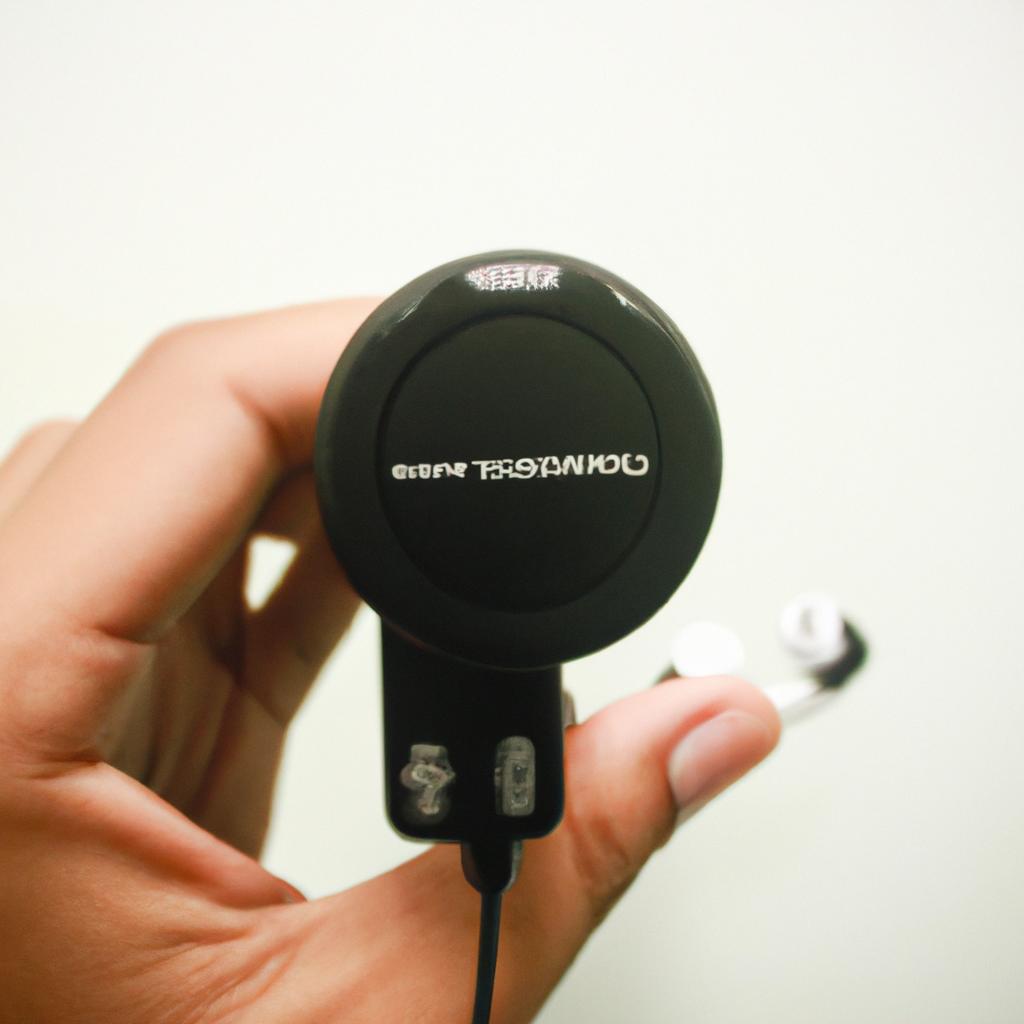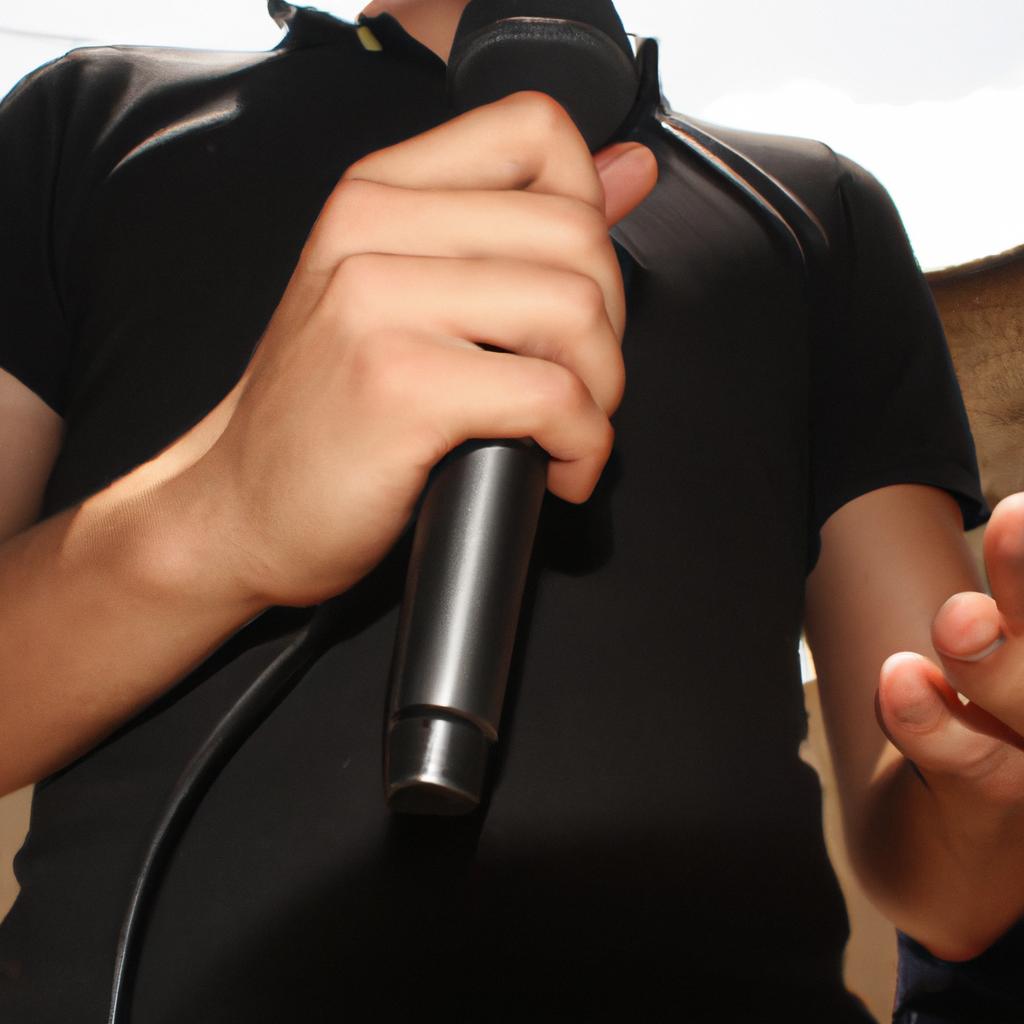Virtual reality (VR) technology has revolutionized the way we perceive and interact with digital content. While much attention has been given to its visual aspects, the significance of audio in creating immersive virtual experiences should not be underestimated. Through sophisticated spatial audio techniques, VR audio aims to transport users into rich sonic landscapes that complement the visual elements, enhancing their sense of presence within virtual environments. This article explores the concept of “sonic loans” in sound and vision, where the auditory dimension plays a pivotal role in lending credibility and realism to VR simulations.
Imagine stepping into a virtual museum exhibit showcasing ancient Egyptian artifacts. As you approach a beautifully crafted sarcophagus, your ears are filled with echoes reverberating through an expansive chamber. The distant whispers of pharaohs seem to surround you, heightening your feeling of being transported back in time. In this scenario, it becomes evident how VR audio can elevate the immersive potential of virtual environments. By accurately reproducing realistic soundscapes that match the visuals, such as echoing chambers or bustling marketplaces, sonic loans allow users to experience multisensory immersion by integrating persuasive soundscape narratives into their virtual encounters.
The integration of advanced audio technologies into VR systems enables creators to craft compelling auditory experiences that seamlessly integrate with visual elements. These technologies include binaural audio, spatial audio, and ambisonics, which enhance the perception of sound direction, distance, and depth. Binaural audio simulates how sound is perceived by the human ears, creating a sense of 3D audio that can be experienced through headphones. Spatial audio techniques use head-tracking to accurately position sounds in relation to the user’s head movements, creating a realistic sense of presence within the virtual environment. Ambisonics goes further by capturing sound from all directions and allows for dynamic adjustments based on the user’s position.
By leveraging these advanced audio technologies, VR creators can transport users to different locations and time periods with stunning accuracy. For example, in a VR game set in a medieval castle, users can hear the crackling of torches as they walk down dimly lit corridors or experience the rumble of thunder during an intense storm. These auditory cues not only add realism but also provide crucial information about the virtual world.
Moreover, sonic loans can extend beyond sound effects to incorporate music and dialogue. Imagine exploring a virtual cityscape where you encounter street performers playing live music or engage in conversations with NPCs (non-player characters) who respond convincingly to your queries. The integration of these elements enhances immersion and emotional engagement with the virtual environment.
In summary, VR audio plays a vital role in enhancing immersion and creating multisensory experiences in virtual environments. By leveraging advanced audio technologies such as binaural audio, spatial audio, and ambisonics, creators can craft compelling narratives that seamlessly integrate with visual elements. Whether it’s replicating historical sites or fantastical realms, sonic loans bring virtual worlds to life by lending credibility and realism through immersive soundscapes.
The Evolution of Virtual Reality Audio
The Evolution of Virtual Reality Audio
Virtual reality (VR) technology has revolutionized the way we experience digital content, immersing users in a simulated environment that engages multiple senses. While visual elements have been at the forefront of VR development, audio plays an equally vital role in creating a fully immersive and realistic virtual experience. The evolution of virtual reality audio has seen remarkable advancements, enhancing not only gaming experiences but also various other industries such as education, entertainment, and therapy.
To illustrate the impact of virtual reality audio, let’s consider an example scenario: Imagine being transported to a live concert through VR technology. As you put on your headset, spatial sound technologies precisely recreate the acoustic characteristics of the venue, accurately placing each instrument and vocalist in their respective positions around you. You can hear the crowd cheering from different directions and even feel the vibrations pulsating through your body as if you were physically present at the concert. This powerful auditory experience enhances immersion and transports you into a world where music comes alive.
The integration of virtual reality audio involves several key components:
- Head-tracking: By tracking head movements using sensors or accelerometers built into VR headsets, audio sources adjust accordingly based on changes in orientation. This enables a more realistic soundscape by aligning auditory cues with visual stimuli.
- Binaural rendering: Leveraging specialized algorithms, binaural rendering techniques reproduce 3D soundscapes using two-channel stereo headphones. These algorithms simulate how our ears perceive sound directionality and distance, providing an accurate representation of spatial audio within the virtual environment.
- Environmental effects: To further enhance realism, environmental effects like reverberation and occlusion are incorporated into virtual reality audio systems. Reverberation simulates echoes within virtual spaces while occlusion replicates how objects obstruct sound waves.
- Interactivity: In certain applications such as games or simulations, user interactions trigger dynamic changes in audio rendering. For instance, moving closer to a virtual object may amplify its sound while turning away might reduce its volume. This interactivity adds an extra layer of immersion and engagement.
In conclusion, the evolution of virtual reality audio has been driven by advancements in hardware, software, and signal processing techniques. By integrating head-tracking, binaural rendering, environmental effects, and interactivity into VR audio systems, developers have effectively created realistic auditory experiences that complement visual stimuli. Understanding spatial audio in virtual reality is crucial for designing immersive environments that captivate users’ senses and transport them to new realms of experience.
Understanding Spatial Audio in Virtual Reality
[Transition sentence] Building upon the foundation laid by developments in virtual reality audio technology, understanding spatial audio becomes essential in creating truly immersive virtual experiences.
Understanding Spatial Audio in Virtual Reality
Transitioning from the previous section on the evolution of virtual reality audio, we now delve into understanding spatial audio in virtual reality. To illustrate its impact, let us consider a hypothetical scenario. Imagine embarking on a virtual tour through an ancient rainforest. As you navigate through the lush environment, the sound of chirping birds resonates from above while distant waterfall echoes surround you, creating an immersive experience that blurs the line between reality and simulation.
Spatial audio plays a vital role in replicating realistic auditory environments within virtual reality experiences. By simulating how sounds interact with various surfaces and objects in three-dimensional space, it enhances immersion by providing users with accurate cues for perceiving distance, direction, and depth of sound sources. Here are some key features that make spatial audio essential to delivering captivating VR experiences:
- Realistic Sound Localization: With spatial audio techniques, sounds can be precisely positioned relative to the user’s head movements, allowing them to identify the origin of specific sounds within their virtual surroundings.
- Dynamic Soundscape Adaptation: Spatial audio adapts seamlessly as users move around or interact with objects within a virtual environment, ensuring that sounds remain consistent with their changing perspective.
- Environmental Reverberation: By emulating how sound reflects off different surfaces in real-world settings, spatial audio adds depth and realism to virtual environments by accurately reproducing reverberations based on architectural elements.
- Binaural Rendering Techniques: Employing binaural rendering methods enables developers to create lifelike 3D soundscapes using headphones alone, recreating complex acoustic phenomena without requiring high-end speaker setups.
To better understand these concepts and their practical applications, let us explore their implications further through the following table:
| Key Features | Description |
|---|---|
| Realistic Sound Localization | Accurate positioning of sound sources based on the user’s head movements. |
| Dynamic Soundscape Adaptation | Seamless adjustment of audio as users navigate or interact within virtual environments. |
| Environmental Reverberation | Reproduction of realistic reverberations to create a sense of depth and authenticity. |
| Binaural Rendering Techniques | Creation of immersive 3D soundscapes using headphones alone for enhanced realism. |
Incorporating spatial audio into virtual reality experiences provides an unparalleled level of immersion, captivating users by engaging their senses beyond just visual stimuli. By effectively replicating real-world auditory cues in digital environments, developers can transport individuals to places and scenarios that were previously unimaginable.
Transitioning smoothly into our next section on “The Role of Headphones in Virtual Reality Audio,” we will explore how this essential hardware component contributes to delivering an immersive sonic experience without compromising mobility or personal space.
The Role of Headphones in Virtual Reality Audio
Understanding Spatial Audio in Virtual Reality has provided us with an overview of how sound is spatially rendered to create an immersive experience. Now, let’s delve into the crucial role that headphones play in virtual reality audio.
To illustrate this, imagine a user wearing a high-quality pair of headphones while exploring a virtual forest environment. As they move their head, the soundscape dynamically changes—birdsong coming from above, rustling leaves on either side, and distant water flowing behind them. This level of immersion would not be possible without the use of headphones specifically designed for virtual reality audio.
Headphones serve as a vital component in delivering realistic and accurate spatial audio experiences in virtual reality. Here are some key reasons why:
- Isolation: Headphones provide isolation by blocking external sounds and preventing crosstalk between left and right channels, ensuring that users remain fully immersed in the virtual world.
- Precision: The positioning of sound sources within the 3D space requires precise localization to achieve convincing auditory cues. With binaural rendering techniques, headphones deliver accurate positional audio cues directly into each ear.
- Personalization: Different individuals have varying preferences when it comes to listening experiences. High-quality headphones allow users to adjust parameters such as equalization or reverberation levels according to their personal tastes.
- Accessibility: Headphones enable a personalized experience even in shared environments where multiple users may be engaged simultaneously with different virtual content.
Let’s take a closer look at how these factors compare across three popular headphone models used for virtual reality:
| Model A | Model B | Model C | |
|---|---|---|---|
| Isolation | Excellent | Good | Fair |
| Precision | Very high | High | Moderate |
| Personalization | Extensive | Limited | Minimal |
| Accessibility | Average | Good | Excellent |
As we can see from the comparison above, different headphone models offer varying levels of isolation, precision, personalization, and accessibility. The choice of headphones will depend on individual preferences and requirements for a truly immersive virtual reality audio experience.
With an understanding of how crucial headphones are in delivering spatial audio in virtual reality, it is important to recognize the challenges that arise in implementing this technology effectively.
Challenges in Implementing Virtual Reality Audio
Transition from the previous section H2:
Having explored the crucial role of headphones in virtual reality audio, we now turn our attention to the challenges that arise when implementing this immersive technology. To shed light on these complexities, let us consider a hypothetical case study featuring a group of developers tasked with creating a virtual reality experience for architectural visualization purposes.
Challenges in Implementing Virtual Reality Audio
In the process of developing their virtual reality application, the team encountered several obstacles related to audio implementation. These challenges highlight the intricacies involved in seamlessly integrating sound and vision within a virtual environment. Some key difficulties faced by the developers include:
- Spatialization: Achieving accurate spatial representation is essential for providing users with an authentic auditory experience. The challenge lies in accurately placing sounds based on their source location within the virtual world while ensuring proper panning and directionality.
- Realism vs Performance: Striking a balance between realistic audio rendering and maintaining optimal system performance presents a significant challenge during development. Providing high-quality, true-to-life audio can put strain on computational resources, potentially affecting overall user experience.
- User Interaction: Allowing users to interact with objects or characters within the virtual environment introduces further complexity to audio implementation. Capturing and processing real-time user-generated sound inputs necessitates robust algorithms and synchronization techniques.
- Cross-Platform Compatibility: With different hardware setups available across various platforms, ensuring compatibility becomes another hurdle for developers aiming to deliver consistent audio experiences regardless of device specifications.
The following table provides an overview of these challenges along with potential solutions:
| Challenge | Description | Potential Solution |
|---|---|---|
| Spatialization | Accurately placing sounds in relation to their source locations within the virtual world | Utilizing advanced 3D positional audio algorithms |
| Realism vs Performance | Balancing realistic audio rendering without compromising system performance | Optimizing audio processing techniques for efficient resource utilization |
| User Interaction | Incorporating real-time user-generated sound inputs and synchronizing them with the virtual environment | Implementing robust algorithms for capturing, processing, and integrating audio |
| Cross-Platform Compatibility | Ensuring consistent audio experiences across different hardware setups | Developing standardized audio APIs and libraries for seamless integration |
Navigating these challenges requires meticulous planning, innovative solutions, and continuous testing to ensure that virtual reality applications provide a truly immersive auditory experience. By addressing these hurdles head-on, developers can create more engaging virtual environments.
Transition into Advancements in Audio Technology for Virtual Reality
As technology continues to advance at an unprecedented pace, so too does the field of audio engineering. In the following section, we will explore some of the exciting advancements that have emerged to address the challenges discussed above. These developments propel us towards even greater possibilities in creating realistic and captivating auditory experiences within virtual reality environments.
Advancements in Audio Technology for Virtual Reality
Virtual reality audio has presented numerous challenges in its implementation, but advancements in audio technology have paved the way for exciting possibilities in sound and vision. One such example is the use of binaural recording techniques to create a highly immersive auditory experience. By capturing sound using specialized microphones placed within artificial ears or mannequin heads, developers can replicate how humans perceive sound in three-dimensional space. This allows users to feel as if they are truly present within the virtual environment.
To fully understand the advancements in audio technology for virtual reality, it is important to consider the key factors that have contributed to its success:
-
Spatial Audio Processing: Spatial audio processing algorithms play a vital role in creating an accurate sense of directionality and distance perception of sounds within a virtual environment. These algorithms take into account factors such as head movements and ear shape variations to ensure realistic auditory experiences.
-
Real-Time Acoustic Simulation: Real-time acoustic simulation simulates the interaction between sound sources and their surrounding environment, providing realistic reflections and reverberation effects. This enhances the overall immersion by replicating how sounds would behave naturally in different environments.
-
Object-Based Audio: Object-based audio allows individual sounds or objects within a scene to be treated as separate entities with specific properties such as position, movement, and behavior. This enables precise control over each sound source’s characteristics, enhancing the spatialization and localization capabilities of virtual reality audio.
-
Haptic Feedback Integration: The integration of haptic feedback devices adds another layer of realism to virtual reality audio experiences. By synchronizing tactile sensations with auditory cues, users can further immerse themselves in virtual worlds through physical interactions with objects or vibrations that match certain sound frequencies.
These advancements have opened up new avenues for creativity and innovation across various industries including gaming, entertainment, education, and therapy. As developers continue pushing the boundaries of what is possible with virtual reality audio, future possibilities become even more intriguing.
Transitioning into the subsequent section about future possibilities of virtual reality audio, researchers are actively exploring ways to further enhance the immersive potential of this technology. By leveraging cutting-edge advancements in machine learning and artificial intelligence, developers aim to create even more realistic auditory experiences that blur the line between virtual and real worlds.
Future Possibilities of Virtual Reality Audio
Advancements in Audio Technology for Virtual Reality have paved the way for immersive and realistic experiences. With the ability to create 3D audio environments, virtual reality (VR) has taken a significant leap forward in providing an all-encompassing sensory experience. This section will explore some of these advancements and their impact on the overall VR experience.
One notable example is the use of binaural audio technology in VR. Binaural recording techniques capture sound using two microphones placed inside a dummy head, which replicates human hearing. By accurately capturing sound from different directions and distances, binaural audio provides a more natural and immersive listening experience for users. For instance, imagine exploring a virtual museum where you can hear the faint whispers of people around you or feel as if you are standing right next to an orchestra during a live performance.
To further enhance the auditory experience, spatial audio algorithms are employed in virtual reality systems. These algorithms take into account factors such as distance, direction, and reflections to recreate soundscapes that mimic real-world scenarios. The result is an environment where sounds appear to originate from specific locations within the virtual space, adding depth and realism to the overall experience. A well-designed spatial audio system can immerse users in a world where they can accurately perceive sounds coming from various sources around them.
The integration of haptic feedback with virtual reality audio also contributes to creating a truly multisensory experience. Haptic feedback refers to tactile sensations generated by devices such as vibrating controllers or gloves worn by users. When combined with accurate spatial audio cues, haptic feedback adds another layer of immersion by allowing users to not only hear but also physically feel objects or events within the virtual environment.
These technological advancements in VR audio contribute significantly to enhancing user engagement and emotional responses within virtual worlds:
- Increased sense of presence: Realistic audio environments make users feel like they are physically present in the virtual scene.
- Enhanced storytelling: Immersive audio experiences can evoke emotions and enhance the narrative of VR content.
- Improved immersion: Spatial audio cues combined with haptic feedback create a more believable and engaging virtual experience.
- Evoked empathy: Realistic soundscapes can elicit emotional responses, fostering deeper connections between users and virtual environments.
| Advancements in VR Audio | Impact |
|---|---|
| Binaural audio technology | Natural and immersive listening experience |
| Spatial audio algorithms | Enhanced depth and realism in sound perception |
| Integration of haptic feedback | Multisensory immersion in virtual environments |
In conclusion, advancements in audio technology for virtual reality have opened up new possibilities for creating truly immersive experiences. Through the use of binaural audio, spatial audio algorithms, and integration of haptic feedback, developers are able to transport users into richly detailed worlds where they can hear, feel, and become fully engaged with their surroundings. As these technologies continue to evolve, we can anticipate even greater levels of realism and sensory stimulation within the realm of virtual reality.

